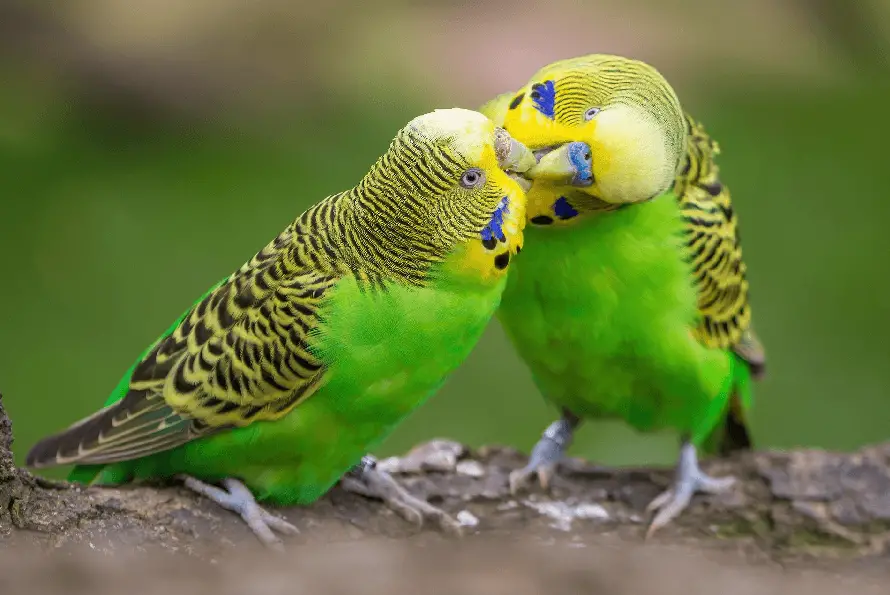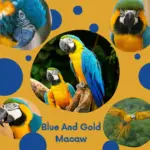
Budgerigar (Budgie Bird) Coming from the desert regions of Australia, budgerigar was not discovered until the 18th century in Europe. With its attractive colors and vitality, it is today one of the most popular and adopted birds in Europe.
Budgerigar scientific name
Budgie description
Budgerigars are 18-24 centimeters long and weigh between 25 and 45 grams. This bird is characterized by its green plumage and yellow head. In captivity, the color of her coat can vary from purple, blue, or gray.
Black stripes are also visible on the top of the skull and on its wings, and there are black spots around its throat. Its beak is short and olive-colored, and its eyes are black.
The color of their cere (soft, fleshy bulge found at the upper part of the base of the beak) is an important indicator: the cere will be beige or dark brown in the female, while it will be bright blue in the male.
Budgie lifespan
Budgerigars usually live between 12 and 15 years.
Budgerigar Reproduction

To reproduce, parakeets must be at least 1 year old regardless of sex. During the breeding season, the behavior of parakeets also varies. The males sing more, feed their partner, and peck lightly on the beak of the latter as if to feed it.
The first egg is laid between 4 and 8 days after mating. The female will then lay about one egg every 2 days. She will generally lay between 5 and 6 eggs, this number can go up to 10. She will then incubate her eggs alone for about twenty days.
When parakeets are born, they have their eyes closed and do not yet have feathers. Their mother will feed them alone and the male will feed the female. Babies’ feathers will begin to appear after 2-3 days as down. The plumage will be complete around 4 to 5 weeks.
They will then enter a phase of discovery where they will begin to learn to feed themselves. The first flights take place around the first 2 months after the parakeets have had time to build up their wings.
Budgie Food
The diet of parakeets should be varied and rich in vitamins, minerals, trace elements, fiber, and protein. A good diet can increase the life expectancy of the animal, increase the beauty of its coat, prevent overweight, and strengthen its immune system.
This should consist of fresh raw fruits and vegetables, sprouted seeds, and young shoots, as well as blocks of minerals, clay, and vitamins.
You can also give them cuttlefish bones, a source of calcium. The extruded food provides a good part of the necessary nutrients.
This type of parrot food prevents the animal from “choosing” its food and thus reduces waste. This food base should be supplemented with fruits, vegetables, sprouted seeds, and other vitamins as we explained previously.
What type of seeds to choose for Budgie Bird?

In order to preserve the digestive system of your parakeets, it is important to vary the type of seeds you give your bird. You must combine seeds dry, the milky seeds and half-ripe, and sprouts.
For dry seeds, there are ready-made mixtures suitable for different breeds of birds, and for milky, semi-ripe seeds you can give your bird wheat, corn, oats, buckwheat, or barley.
Regarding germinated seeds, they provide a high level of vitamins A, B, and C. Very nutritious, they are therefore essential for the diet of parakeets.
What fruits and vegetables should I give my Budgie Bird parakeet?
Green foods, yellow and orange are the most popular in general. You can give your bird spinach leaves, the endive, the apple, the kiwi or carrots, or even the pumpkin, etc. Occasionally, a few nuts are welcome.
Choose almonds, pistachios, hazelnuts, various nuts, peanuts, or even flax, rice, chia, corn, squash, sesame, or sunflower seeds.
The fatty acids contained in these seeds protect the cardiovascular system because they are rich in iron, vegetable proteins, magnesium, and Omega-3.
As a reward for your parakeet, you can occasionally give it treats. The most popular are usually millet, corn, and sunflower seeds.
Budgie habitat
Despite their small build, parakeets need a lot of space to roam and play. Parakeets require a space of at least 1m². This applies to 1 or 2 animals, when we reach 3 or 4 parakeets, it will take 2m², for 5 or 6 parakeets, it would take 3m², and so on. The ideal is to have a room reserved for them so that they can really flourish and fly as they see fit.
Accessories are also necessary for the well-being of these animals:
- The troughs: They allow your parrots to drink. Many models hang on the wire mesh of the cage. The water should be changed every day. You can also use bowls that hang on the cage grids or which rest on a flat place in which the bird will have free access to the water. It is also possible to install a small water fountain in your pet’s cage, which requires daily renewal of the water.
- The feeders: Different types of feeders exist. You can buy a classic bowl that can be placed on the ground or hung on the cage grids. They are usually made of plastic, ceramic, or stainless steel and allow free access to food and easy renewal of seeds. Distributor feeders also exist, the most common being the so-called “commodore” feeder. It is one of the most hygienic and economical solutions, and the bird has no real possibility of sorting its food.
- The baths: This accessory will allow the bird to moisturize and have fun. This enhances the beauty of the plumage. However, it is preferable to install a bathtub outside the cage as baths should always be taken under supervision.
- The perches: The ideal is to propose wooden perches natural and raw, ie not smoothed and bark. You can even cut fresh tree branches and hang them from the bars of the cage. Apple, pear, bamboo, birch, willow, or even hazel branches may be suitable. You can also add cotton ropes, small ladders, or rings of rope to vary the elements of your pet’s environment.
- The games: they will allow the birds to have fun and will participate in their well-being by channeling their energy. You can easily find wooden trees or play areas that will delight your birds.
The truth about owning a budgie
Budgie Care
In order to avoid infections and the risk of disease, it is necessary to regularly clean and sanitize the animal’s environment.
The bird’s cage should be cleaned and disinfected. First of all, cleaning removes dirt and therefore makes the cage clean. Disinfection eliminates microorganisms and viruses present in the cage.
Cleaning is necessary and disinfection is complementary. The ideal would be to clean the bottom of the cage daily using a specific detergent or disinfectant, or even washing up liquid and a sponge. You can also use a toothbrush to reach the corners of the cage. The drinker and feeder should also be cleaned daily.
Different symptoms can be signs of the disease. First of all, a sick parakeet is less active, sleeps more, and is listless. She appears dejected, often keeps her eyes closed and her appetite is reduced. She also adopts a more solitary demeanor and shows no curiosity.
Physical signs can also indicate a possible illness. Changes in the plumage, breathing, droppings, and behavior of the animal may appear. The parakeet can also undergo significant weight loss. Budgerigars can be affected by different pathologies.
- The fungal infection: The infection caused by a fungus is one of the major diseases affecting birds. When a parakeet is infected with a yeast infection, it suffers from difficulty in breathing, coughing fits, rattling, and wheezing. The bird may have difficulty opening and closing its beak. The diagnosis of mycosis is made by a blood test. An aerosol treatment, as well as an antibiotic treatment, will be administered to the bird.
- The scab is Caused by mites digging tooth and wax parakeets, the disease is characterized by white-beige crusts crumbling on the spout. A parakeet affected by scabies will tend to scratch at the lesions. Scabies prevents the animal from eating properly. Treatment must be set up quickly: an ointment or drops are to be applied to the beak. As this disease is highly contagious, it is best to keep other birds away from the sick parakeet and to clean the cage and accessories to avoid further contamination.
- Salmonellosis: This bacterial disease causes vomiting, diarrhea, weight loss, tremors, and coordination problems. In order to diagnose the responsible bacteria, a bacteriological examination is performed. Once the bacteria have been identified, antibiotics should be administered to the parakeet.
Our advice for choosing your budgie
When you go to buy or adopt a parakeet, pay attention to where the bird lives. It should be clean, bright, and airy. Then observe the parakeets, they must be dynamic, have clear plumage, and have keen eyes.
Pay special attention to the animal’s wax, its paws, and around its eyes and beak. The animal must also have good body support.
Parakeets can either be tutored by their parents or by a breeder who took the place of the parents for different reasons. When educated by a human, parakeets become more easily tame and docile.
However, studies have shown that the so-called “hand-pruning” (by a man and not by the parents) can have bad impacts on the behavior of parakeets in the long term: biting, anxiety, pecking, self-harm …
Regarding the choice of the sex of the bird, there is no real difference between males and females. If you want to teach your parakeet a few words, males usually speak more easily than females.
However, if trained young, a female will be able to speak just as well as a male. Physically, to recognize a male from a female, males have light blue cere, while females have brown-beige cere.
Budgie Bird Talks To Owner To Stop Feeling Lonely
SOURCE:BBC Earth
Budgie species
Budgerigars (Budgie Bird) are just one of the many different species of budgies that exist. There are green-winged parakeets, blue-necked parakeets, ring-necked parakeets, blue or red-rumped parakeets, Alexandre parakeets, mustache parakeets, Mauritius parakeets, etc.
A Budgie Bird, named Puck, holds the world record for the largest bird vocabulary, with more than 1,728 different words spoken. He even knew how to create his own expressions and sentences.
Adopting a pet comes with responsibilities, take the time to think about it before welcoming a new member to your family.
The difference between these two birds is in the tail. It is long in the parrot, short in the parakeet. The most common species found in pet stores is the budgie.
yes Budgie Bird are social birds and easily hand tamed, This small parrot is exceedingly friendly
Give your Budgie Bird good food nice place and a good cage to live in and the most important part is much love




















